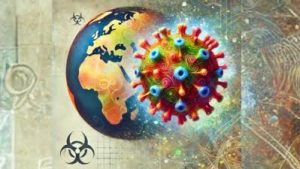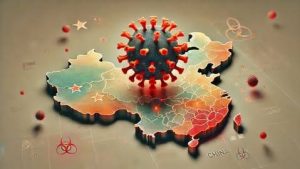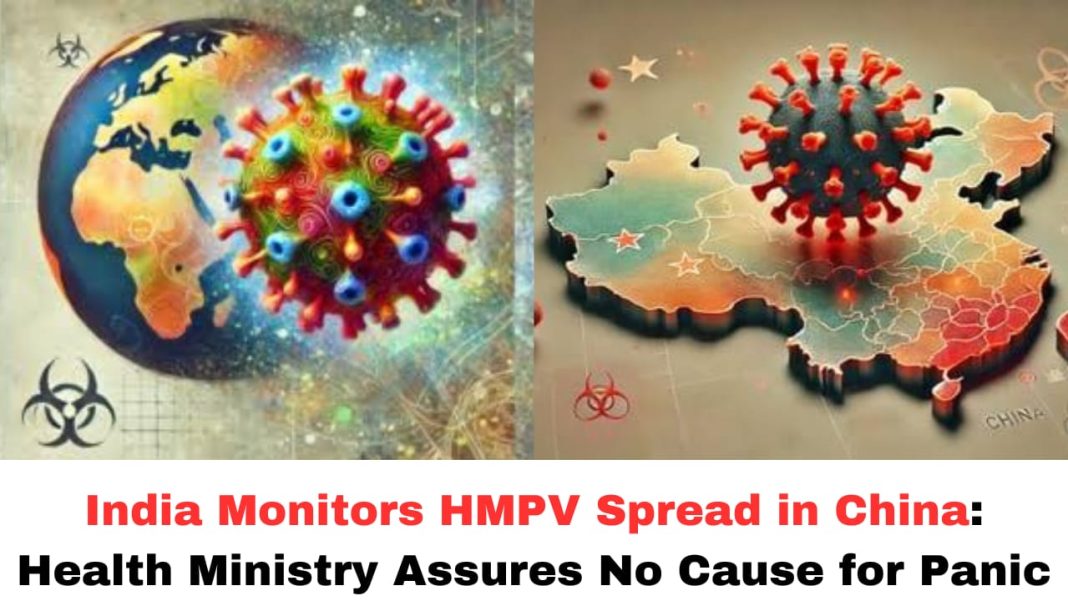Digital News Guru Current Affairs Desk:
The Indian government is keeping a close watch on reports of a rise in respiratory infections in China, particularly involving the Human Metapneumovirus (HMPV). This development comes amidst concerns over the increasing spread of winter respiratory illnesses globally. However, the Ministry of Health and Family Welfare has reassured the public that there is no immediate cause for alarm, citing robust surveillance systems and preparedness to handle any potential challenges.
Understanding HMPV
Human Metapneumovirus (HMPV) is a common pathogen associated with respiratory infections, often seen in children, the elderly, and individuals with compromised immune systems. It typically causes symptoms like fever, cough, nasal congestion, and in severe cases, bronchitis or pneumonia. The virus is similar to the respiratory syncytial virus (RSV) and is known to spread during the colder months, leading to seasonal surges.

HMPV is not new to the medical community. It was first identified in 2001 and has been studied extensively since then. Like other respiratory pathogens, it spreads through droplets when an infected person coughs or sneezes. While most cases are mild, severe infections can occur in vulnerable populations, necessitating hospitalization.
Situation in China
China has reported an uptick in respiratory illnesses this winter, with HMPV identified as one of the contributing factors. However, Chinese health authorities have downplayed the severity of the situation, stating that this year’s infections are less severe than those observed last year. This statement aims to alleviate concerns about any potential pandemic-like scenario.
Despite this reassurance, the news has drawn attention internationally, particularly given China’s role as a major travel hub. With millions traveling in and out of the country daily, the risk of cross-border transmission of respiratory illnesses remains a focal point for global health agencies.
India’s Response and Preparedness
The Indian government has responded proactively to these reports. A Joint Monitoring Group, chaired by the Director General of Health Services, convened to evaluate the situation and ensure that adequate measures are in place to prevent any adverse impacts domestically.
The Health Ministry emphasized that India’s surveillance systems for Influenza-like Illness (ILI) and Severe Acute Respiratory Illness (SARI) are functioning effectively. These systems regularly track trends in respiratory illnesses across the country, allowing for early detection and intervention in case of unusual surges.
The Indian Council of Medical Research (ICMR) has also announced plans to enhance laboratory testing for HMPV. This initiative includes year-round monitoring of respiratory illness trends and an increased focus on understanding the prevalence and impact of HMPV in India. These measures are designed to bolster the country’s ability to respond swiftly and effectively to any emerging threats.
Reassurance from Health Authorities
In a public statement, the Health Ministry reassured citizens that there is no need to panic. Officials have noted that the rise in respiratory illnesses in China aligns with typical seasonal trends observed during the winter months. Common pathogens such as HMPV, Influenza, and RSV are often responsible for such increases, and India is well-equipped to manage them.

Hospitals across the country have been instructed to remain vigilant and ensure that they are prepared to handle any spike in respiratory cases. The Health Ministry has reiterated the importance of standard precautions, such as wearing masks in crowded areas, maintaining good hand hygiene, and avoiding close contact with individuals exhibiting symptoms of respiratory infections.
Lessons from the COVID-19 Pandemic
The global response to the COVID-19 pandemic has significantly improved health infrastructure and preparedness in many countries, including India. Surveillance systems, laboratory networks, and public health awareness have all been strengthened in the aftermath of the pandemic.
These improvements have positioned India to respond more effectively to potential health crises. The lessons learned from COVID-19, particularly the importance of early detection, public communication, and international cooperation, are being applied in the current situation.
Global Implications
The rise of HMPV in China serves as a reminder of the interconnectedness of global health. While the virus itself is not new or highly alarming, its spread highlights the need for ongoing vigilance in monitoring respiratory illnesses, especially in the context of international travel and trade.
The World Health Organization (WHO) has also taken note of the situation, emphasizing the importance of transparency and collaboration between nations in addressing health threats. The WHO continues to work with countries to strengthen global health security and ensure that effective measures are in place to prevent the spread of infectious diseases.
Public Health Advice
For the general public, the best course of action is to adhere to preventive measures that are effective against most respiratory infections:
- Wash hands frequently with soap and water or use hand sanitizers.
- Avoid touching the face, especially the mouth, nose, and eyes.
- Wear masks in crowded or poorly ventilated spaces.

- Seek medical attention promptly if experiencing severe respiratory symptoms.
- Maintain a healthy lifestyle to boost immunity, including a balanced diet and regular exercise.
Conclusion
India’s proactive approach to monitoring the HMPV situation in China reflects its commitment to safeguarding public health. By leveraging its robust surveillance systems and pandemic preparedness, the country is well-positioned to address any challenges posed by respiratory illnesses this winter.
While the current reports of HMPV spread in China are concerning, the Health Ministry’s assurance of no unusual trends domestically is a reassuring signal. Public adherence to health guidelines, combined with government vigilance, will play a crucial role in ensuring that the situation remains under control.
You May Also Read: Delhi’s Longest Fog Spell of the Season: 9 Hours of Zero Visibility








